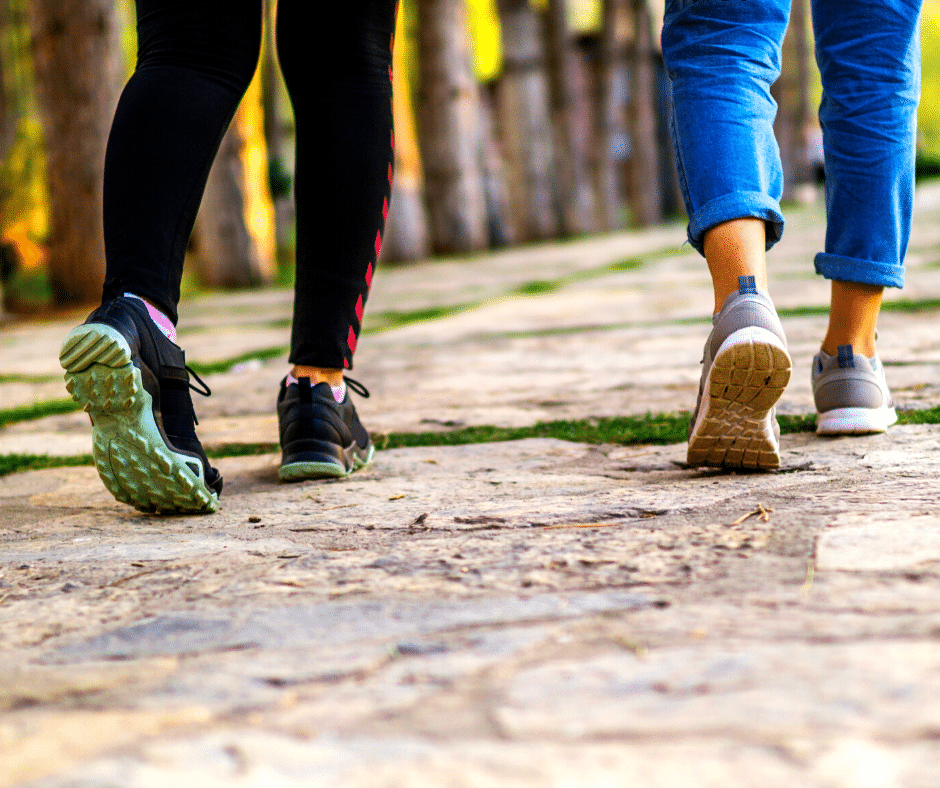Did you know there is a normal everyday activity that can be counted as exercise, and can help reduce the risk for stroke, type II diabetes, and can help with weight loss? This underrated exercise is walking!

While walking does not always come to mind when thinking about getting in your 30 minutes of cardio activity, it can offer similar benefits to running without the impact on your joints. According to Mayo (2019), a few of the physical benefits to going for a brisk walk on a regular basis are:
- Maintaining a healthy weight
- Preventing or managing various conditions like heart disease, high blood pressure, and type II diabetes
- Strengthening your bones and muscles
- Improving your balance and coordination
In addition to the physical benefits, walking also offers mental health benefits – improved mood, better concentration and creativity, reduced stress, and a lower risk of developing depression. There is also evidence that shows walking can reduce your risk of dementia and other age related memory loss (Arthritis Foundation, N.D., and Harvard Health Publishing, 2010, updated 2020).
One thing to remember is that regular moderate to vigorous walking sessions are required for maximum cardiovascular and physical benefits. However, the average stroll through the neighborhood is a good place to start building your endurance and you still benefit from getting movement into your day. No time? No problem! You can still get 30 minutes of walking into your day if you do it in 10-minute segments throughout the entire day.
As we recognize National Walking Day (the first Wednesday of April), here are some lesser-known facts that may inspire you to lace up those walking shoes:
- Walking (more accurately race walking) is an Olympic sport and has been since 1904 (Parkar, 2021), and competitively trained racewalkers can outpace joggers (Harvard Health Publishing, 2010, updated 2020).
- It can help you curb those cravings for sweets! A study completed by the University of Exeter found that walking for 15 minutes helped ease the cravings for chocolate. Other studies have found that going for a walk helps reduce your cravings for sweets (Harvard Health Publishing, 2019, updated 2020).
- Walking can boost creativity up to 60% (ACE, 2015)
- You use about 200 muscles while walking (ACE, 2015)
If you want to get some fresh air on your walk, the Be Well Path at Windom Area Health is open in the spring, summer, and fall for everyone to use. If you prefer an indoor stroll, the Wellness Center has treadmills for members to use during hours of operation. No matter your preferred place to get moving, enjoy the walk!
By Lindsey Englar, Wellness Center Coordinator
Sources:
American Council on Exercise (ACE). 2015. Walking toolkit. https://acewebcontent.azureedge.net/assetportfoliodownloads/WalkingFunFacts-2015.pdf
Arthritis Foundation. (n.d.). 12 Benefits of walking. https://www.arthritis.org/health-wellness/healthy-living/physical-activity/walking/12-benefits-of-walking
Harvard Health Publishing. (2010, April updated 2020, October 13). Walking: your steps to health. https://www.health.harvard.edu/staying-healthy/walking-your-steps-to-health
Harvard Health Publishing. (2019, July updated 2020, October 13). 5 surprising benefits of walking. https://www.health.harvard.edu/staying-healthy/5-surprising-benefits-of-walking
Mayo Clinic Staff. (2019, February 27). Walking: trim your waistline, improve your health. https://www.mayoclinic.org/healthy-lifestyle/fitness/in-depth/walking/art-20046261
Parkar, U. (2021, February 10). Race walking: origin, rules, and Olympic history. https://www.olympicchannel.com/en/stories/news/detail/all-you-need-to-know-about-race-walking/
